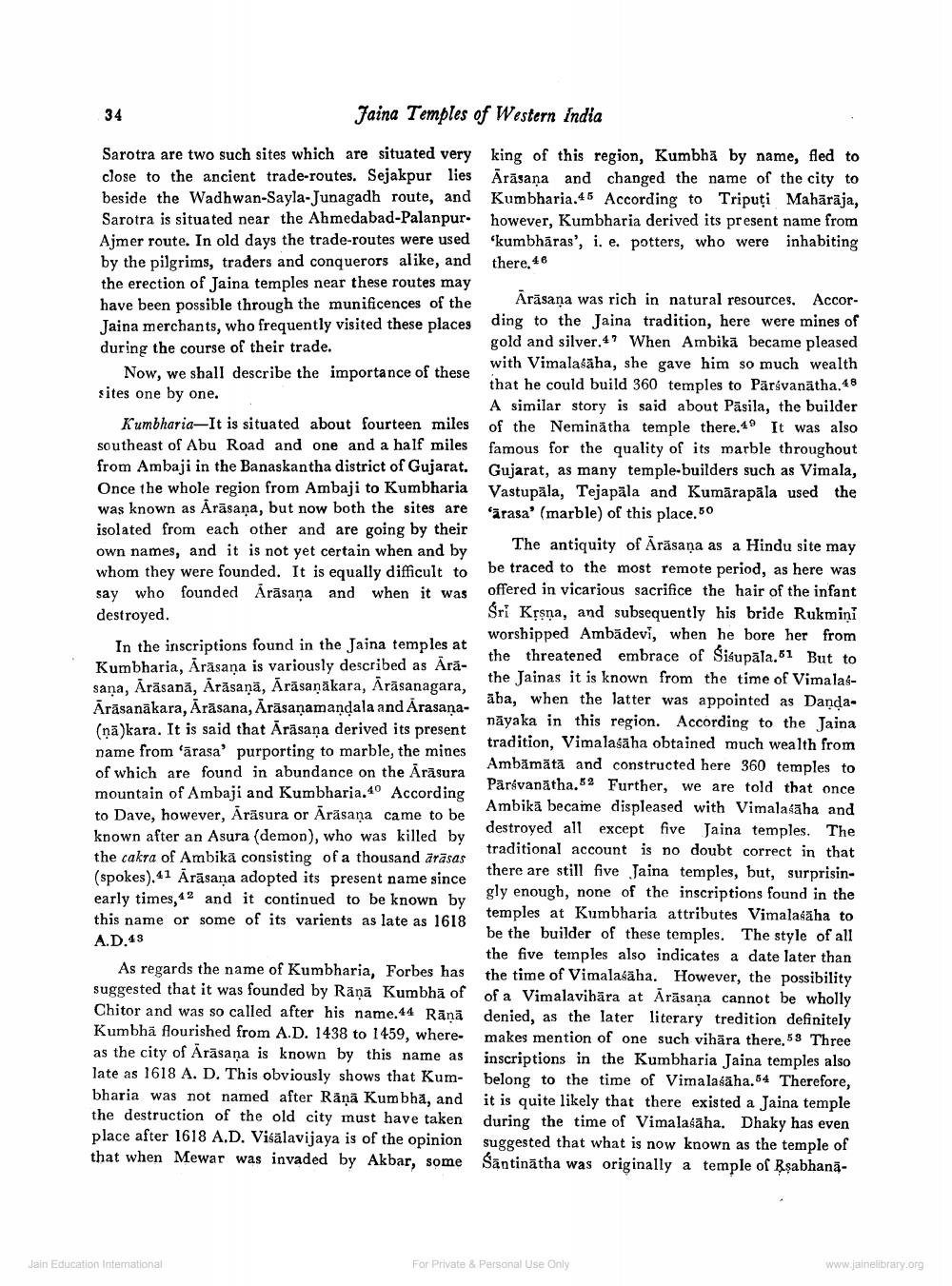________________
34
Faina Temples of Western India
Sarotra are two such sites which are situated very king of this region, Kumbhā by name, fled to close to the ancient trade-routes. Sejakpur lies Ārāsana and changed the name of the city to beside the Wadhwan-Sayla-Junagadh route, and Kumbharia.45 According to Triputi Mahārāja, Sarotra is situated near the Ahmedabad-Palanpur. however, Kumbharia derived its present name from Ajmer route. In old days the trade-routes were used 'kumbhāras', i, e. potters, who were inhabiting by the pilgrims, traders and conquerors alike, and there 46 the erection of Jaina temples near these routes may have been possible through the munificences of the
Ārāsana was rich in natural resources. AccorJaina merchants, who frequently visited these places ding to the Jaina tradition, here were mines of during the course of their trade.
gold and silver.47 When Ambikā became pleased
with Vimalasāha, she gave him so much wealth Now, we shall describe the importance of these
that he could build 360 temples to Pärsvanätha. 48 sites one by one.
A similar story is said about Pasila, the builder Kumbharia-It is situated about fourteen miles of the Neminātha temple there.49 It was also southeast of Abu Road and one and a half miles famous for the quality of its marble throughout from Ambaji in the Banaskantha district of Gujarat. Guiarat, as many temple-builders such as Vimala, Once the whole region from Ambaji to Kumbharia Vastupāla, Tejapāla and Kumārapāla used the was known as Arāsana, but now both the sites are
‘ärasa' (marble) of this place. 50 isolated from each other and are going by their own names, and it is not yet certain when and by
The antiquity of Ārāsaņa as a Hindu site may whom they were founded. It is equally difficult to be traced to the most remote period, as here was say who founded Arāsana and when it was offered in vicarious sacrifice the hair of the infant destroyed.
Sri Krsna, and subsequently his bride Rukmini
worshipped Ambädevi, when he bore her from In the inscriptions found in the Jaina temples at
the threatened embrace of Sigupāla.61 But to Kumbharia, Ārāsaņa is variously described as Āra
the Jainas it is known from the time of Vimalassaņa, Ārāsanā, Ārāsaņā, Ārāsaņākara, Ārāsanagara,
aba, when the latter was appointed as DandaĀrāsanākara, Ārāsana, Ārāsaņamandala and Arasaņa
nāyaka in this region. According to the Jaina (nā)kara. It is said that Ārāsana derived its present
tradition, Vimalasaha obtained much wealth from name from 'ārasa' purporting to marble, the mines
Ambāmātā and constructed here 360 temples to of which are found in abundance on the Arāsura
Paravanatha.52 Further, we are told that once mountain of Ambaji and Kumbharia.40 According
Ambika became displeased with Vimalagaha and to Dave, however, Arāsura or Ārāsaņa came to be
destroyed all except five Jaina temples. The known after an Asura (demon), who was killed by
traditional account is no doubt correct in that the cakra of Ambikā consisting of a thousand ārāsas (spokes). 41 Arāsana adopted its present name since
there are still five Jaina temples, but, surprisin
gly enough, none of the inscriptions found in the early times, 42 and it continued to be known by this name or some of its varients as late as 1618
temples at Kumbharia attributes Vimala aha to be the builder of these temples. The style of all
the five temples also indicates a date later than As regards the name of Kumbharia, Forbes has the time of Vimalasaha. However, the possibility suggested that it was founded by Ränä Kumbhā of of a Vimalavihāra at Arāsana cannot be wholly Chitor and was so called after his name.44 Rānā denied, as the later literary tredition definitely Kumbhā flourished from A.D. 1438 to 1459, where. makes mention of one such vihāra there, 53 Three as the city of Ārāsana is known by this name as inscriptions in the Kumbharia Jaina temples also late as 1618 A. D. This obviously shows that Kum- belong to the time of Vimalagaha.54 Therefore, bharia was not named after Raņā Kumbha, and it is quite likely that there existed a Jaina temple the destruction of the old city must have taken during the time of Vimalašāha. Dhaky has even place after 1618 A.D. Visālavijaya is of the opinion suggested that what is now known as the temple of that when Mewar was invaded by Akbar, some Santinātha was originally a temple of Rşabhana
A.D.43
Jain Education International
For Private & Personal use only
www.jainelibrary.org




